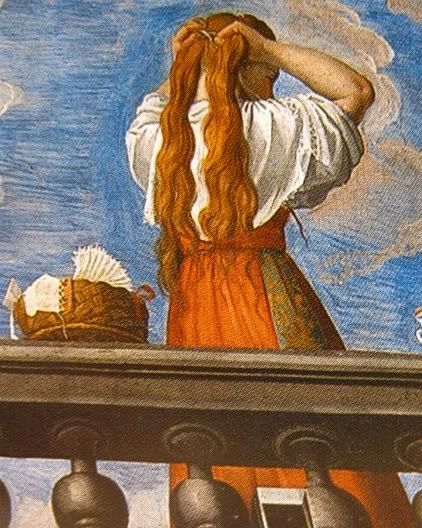A couple of years ago, this painting began to circulate in the Renaissance costuming circles like wildfire. The question that came up was a simple one; what the heck is she wearing? Theories included some sort of petticoat stays despite it being the wrong region and a few decades two early, some sort of white gown, or just some early prototype of stays.
The painting is housed at the Belluno Civic Museum. The museum isn't as grand as some of the others I've been to in Italy but it does have a few curious pieces, such as this beauty. The painting is large and it's easy to see details in it. That said, I'd like to start with tackling the petticoat stays theory regarding this painting.
Many people theorized the petticoat stays due to the fact she's combing her hair, her sleeves are rolled up and the lines in the painting make it look like stitching lines you'd see in stays. However, this is not the only painting to show a woman doing her hair or with her sleeves rolled up.
The above is from much later in the 1580s and was painted by Alessandro Allori. It's part of a ceiling in Florence. The lady is putting ribbons in her hair to wrap it up around her head. Also, notice, she too has her sleeves up. If you have big baggy sleeves, you'd want them out of the way too when you are doing your hair. It's highly annoying otherwise.
However, having rolled up sleeves wasn't just a "brushing your hair" thing. This lady, from 1548, is currently house in the Louvre. However, the painting is done by the Venetian artist Veronese. Starlight Masquerade has a much large photo with a bit more information. The nice thing about this painting is that it's closer to the time period suggested by the museum of the lady combing her hair painting.
Of course, the important thing that has confused many people are the apparent lines that suggest stays. Having seen the painting in person, I can say they aren't stitch line. Really, is a combination of the painting being old and wrinkled (maybe it's the lines of the canvas underneath?) and what were probably, orginally, pinstripes.
Close up detail of the shoulder area. Here, you can faintly see what look like white on cream pinstripes. The dress is a different color than the chemise and the partlet underneath. This is even more apparent in person than it is here.
This is what killed any idea that is could be any type of petticoat stays. The lines are on the skirt as well. However, notice that you can see two distinctive folds in the skirt - one in the dead center and another near the ring finger. This appears in a few other paintings and may be some sort of dog-legged closure.
The strips and gathering in the skirt are even more apparent beneath her arm to the right of the comb. If the bodice of the gown was made into stays, then the skirt wouldn't have the same, even lines.
Really, it reminds me of the fabric shown in Marietta Robusti's self portrait from much later in the century.
Although I'm personally now sure that the painting shows a dress and not any chance of it being stays, what has me still curious about it is the dating. The lady combing her hair looks to be from at least a decade or two later than the given date. By the tail end of the 1530's, the pointed waistline came in but this seems to fit more with the 1540s or 1550s overall in style. Rather than the 1530s as the Museum has it, I'd put it in the 1540s.








0 comments:
Post a Comment